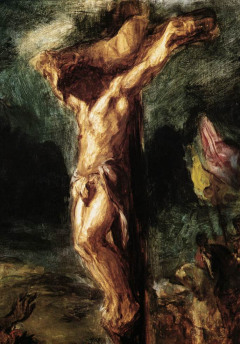There is considerable dispute on this issue, and the archeological and historical evidence is not decisive either way. However, the linguistic evidence, by itself, favors that Christ died on a stake rather than a cross.
The main weight favoring a single stake (pole) being Jesus' instrument for crucifixion comes from the basic meaning for the Greek word stauros (Strong's Concordance #4716), which is translated as "cross" in most Bibles. This word, such as used by the epic poet Homer, means a stake without any crossbeam attached.
Another word, translated "tree," from the Greek word xulon (Strong's #3586) is also used to refer to the instrument that killed Jesus (Acts 5:30, 10:39). This word has the basic meaning of "wood," although it can also mean a pole or stake.
Another thing to consider in regard to Jesus' death is how various ancient pagan religions, such as that of Egypt, used forms of the cross as symbols. The simplicity of the design and its ability to be varied no doubt encouraged different cultures to use it, and they may have devised it separately from one another.

If one could prove the early Catholics took this symbol from the surrounding pagan culture of Rome, it would be good evidence that it has a pagan origin.
Physical evidence
Concerning physical evidence, the parts of two recently discovered ancient corpses possessed the marks of a crucifixion. In the first corpse, a long single nail was found through both feet at the region of the ankles, supporting the argument they were hung on a stake. However, it was not long enough by itself to go securely into the main pole, so this person, like many others crucified, would have had a block of wood for the buttocks to sit on. This would help prevent the nails in the wrists from ripping through the hands.
In a number of cases, however, the arms of those tortured to death by crucifixion were tied up using ropes instead of using nails that pierced the flesh. In the second ancient corpse mentioned above, the victim had a "scratch" on the forearm, but the wrist was undamaged, so it is not fully clear if the victim died on a cross.
Burden of the condemned
Yet another fact to take into account is whether the condemned, as happened to Jesus, routinely had to carry the whole cross or stake they would die on, or just a crossbeam (see Matthew 27:31 - 32, Mark 15:20 - 21, John 19:17).
Roman Catholic tradition favors the view that he carried only the crossbeam to Golgotha. If this has a solid historical basis, then it may overturn the linguistic evidence cited above, depending on how reliable and early are the references it uses.
An early Catholic writer, Tertullian, in the late second century said believers would "mark the brow with the sign of the cross" during such activities as meals, going to bed, and leaving and entering home.
Regardless of whether the instrument on which Jesus did die was a stake or cross, the entire world should appreciate and accept the sacrifice he made on our behalf. He humbled and abased Himself by undergoing a particularly cruel, painful, and disreputable form of capital punishment in order to save us all from our sins.